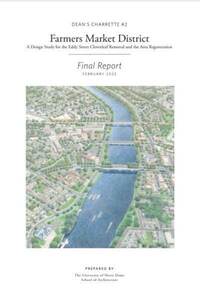Housing and Community Regeneration Initiative
The University of Notre Dame School of Architecture's Housing and Community Regeneration Initiative is a "Think-and-Do Tank" that provides assistance to municipalities and nonprofit organizations to improve economic development by reimagining the built environment.
Our work targets immediate local impact as well as national and global influence through case studies, design studies, and research. Three interrelated activities form the framework for the Housing and Community Regeneration Initiative: community-based design charrettes, education, and research & policy. Faculty, students, and collaborating professional teams carry out these activities under the leadership of the School’s dean, Stefanos Polyzoides, and the Initiative’s director, Marianne Cusato.
The 100-Mile Coalition
After three years and six Dean's Charrettes within northern Indiana and southwest Michigan, we have launched the "100-Mile Coalition." Each year we will bring together a group of cities and nonprofits within a 100-mile radius of the University of Notre Dame that are working to address issues relating to housing shortages, disinvested communities, failed infrastructure, stagnant economic growth, and talent and workforce retention.
Areas of Focus:
- Creating human-scale walkable communities
- Repairing abandoned, vacant, and underutilized properties
- Reducing critical housing shortages
- Addressing inequities resulting from a legacy of housing and transportation policy
- Mitigating the impact of climate change through sustainable development patterns of growth
Select Projects

Dean's Charrette #3
Downtown Kalamazoo, MI
A Study of Urban Sequences & Activation of the Public Realm
The City of Kalamazoo, MI engaged the University of Notre Dame School of Architecture’s Housing and Community Regeneration Initiative to develop a downtown vision to help repair the damage from Urban Renewal and reconnect activity throughout the downtown core.
The study operates at two levels. The first seeks specific strategies to activate the public realm at street level through catalytic design proposals. The second is an exploration of how to connect isolated pockets of activity throughout the city.

Dean's Charrette #2
Farmers Market District
A Design Study for the Eddy Street Cloverleaf Removal and the Area Regeneration
The City of South Bend engaged the University of Notre Dame School of Architecture to offer solutions for reversing the damage done by freeway-like Urban Renewal elements from the 1960’s. The team envisioned strategies for repairing the neighborhood fabric and activating the riverfront by replacing the ramps with pedestrian friendly streets.
The catalyst for this exercise was to position the City of South Bend to attract Federal funding from the 2021 infrastructure bill. Using the work produced in this charrette, the City of South Bend was awarded $2.4 million in Federal funding to engineer the removal of the ramps.

Dean's Charrette #1
William Street Seam
A Design Study for Urban Edge of Downtown South Bend, IN
The William Street Seam was chosen as the subject for the first Dean’s Charrette because it illustrates the physical, social, and economic benefits of the seamless reconnection between the historic neighborhoods of South Bend and its downtown.
The challenge of this project is to illustrate a vision, process, and implementation approach that would promote the area’s urban regeneration and help establish the impression and reality that downtown South Bend can once again become a reliable place to live, work, and invest.
To learn more or request project assistance, contact Marianne Cusato, Professor of the Practice and Director of Housing and Community Regeneration Initiative, at mcusato@nd.edu.
In the News





